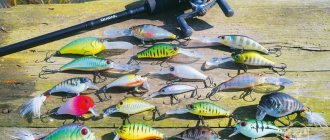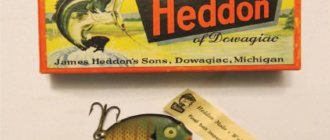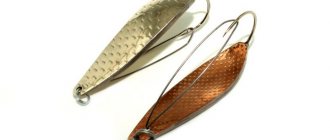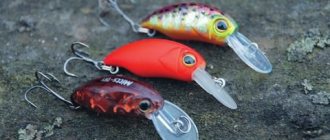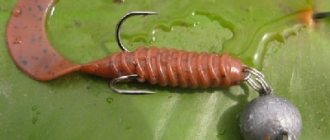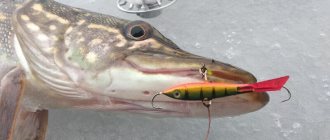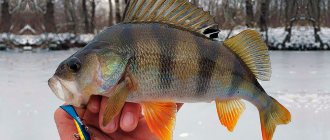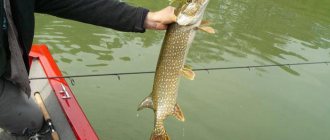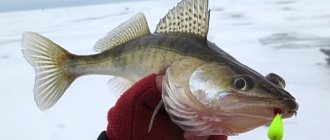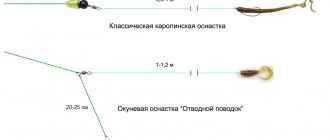Before you start making balancers with side wings with your own hands, evaluate the wiring of the baits in a short video and think about whether these horizontal spoons are suitable for fishing in the reservoirs you visit most.
To begin with, you can read the introductory material devoted to the description of the balancer for catching perch in winter fishing, starting by watching a video with voiced explanatory text.
And for fishermen who have already decided to replenish their bait collections with balancers that are quite promising for winter fishing, let’s start making our own baits by choosing the material for the bodies and lifting wings.
Homemade balancers with wings belong to the class of perch spinners with a horizontal orientation in space. When suspended on a fishing line, the longitudinal axis of the balancer in real perch fishing conditions is located at a slight angle to the horizontal plane.
If you carefully watched the video footage, you might have noticed that high-quality wiring of self-made balancers with side wings does not require a deep reservoir - the wings create sufficient lifting force for the baits during any play of the balancer.
Thanks to their design features, balancers with wings located on both sides of the bait’s body can describe various wiring curves, creating low-frequency acoustic waves in the water, which attracts the attention of perch and other predatory fish to their individuals.
Thanks to the possibility of bending the side blades - the wings - the trajectories of horizontal perch baits can be adjusted and changed within a fairly wide range.
To begin with, I will outline a few tips that will not be superfluous when making any of my homemade balancers with your own hands using a minimum of home tools.
Balancer body shape with wings
Look at the photographs for the body shapes of self-made balancers with wings. The video shows three of the lures shown in the picture. To improve speed characteristics, all balance beams have narrowed nasal ends.
Also, balancers with a shape reminiscent of the outline of a small fish should have both side planes smoothly curved, forming a relatively narrow body, ending in a narrowing at the tail end.
Balancers with a laterally flattened shape have less stable wiring characteristics than similar wide industrially manufactured balancers. But the side wings and volumetric attachments on the tail hooks more than compensate for this disadvantage of homemade balancers.
The photo shows the bending shape of the metal spring of a homemade nod, which controls the wiring of self-made balancers with two side lifting wings.
The laterally flattened shape of all the designs of my balancers presented on the website does not allow the baits to dive deeply into the depths of the reservoir.
But on a stretched fishing line, subject to the vibrations of the nod spring, homemade balancers with side wings can write out different trajectories of wiring in the horizontal plane. This is what attracts the attention of perch or other predatory fish.
Patterns of balancer petals with wings
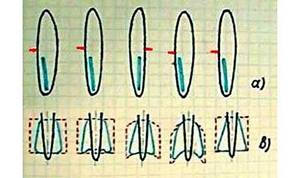
Drawings of balancer patterns and wing shapes for homemade baits with horizontal wiring are presented in the photo.
But, if you intend to make your own balancers with the same body shapes shown in the video for catching perch or pike at depths of up to 4-5 meters and for fishing line or braid with a diameter of up to 0.18-0.2 mm, then the dimensions of the patterns in the drawings, increase by about a quarter.
Drawings of any balancer pattern that suits you can be enlarged on a computer in a graphics editor. The shapes of the wings in the drawing are not tied to the body pattern of any particular balancer. So you can shuffle the patterns of the balancer bodies and wings together as you like.
Strike Pro Balancers
30 December 2014 16:11
In this material we will look at several series
of Strike Pro balancers (Taiwan).
Despite the fact that these lures are not new and have already proven their effectiveness in practice, some features are still relevant, knowledge of which can significantly increase catches on Strike Pro balancers.
Strike Pro Ice Baby Series.
Includes three models of balancers with standard sizes 21mm/4.1gr, 24mm/5.5gr and 25mm/6gr. All models were developed specifically for catching perch at shallow depths, mainly up to 3-4 meters. However, as practice has shown, fishing with these balancers in calm water will be quite comfortable even at 6-8 meters. Compact and at the same time heavy, Ice Baby balance beams have a strongly flattened head, which creates strong resistance when diving. A short body with a rather massive tail makes the bait “slow down” even more, making the game smooth and wide. At the beginning of fishing, it is recommended to play with the rod more sharply, but with a short amplitude; a “throw” of 10-15 cm is quite enough. In this case, the balancer moves significantly away from the hole, moving along a strongly elongated “figure eight”. The bait is characterized by high stability of play without the nose lifting up when turning, thereby eliminating the possibility of the fishing line getting caught. To quickly search for a predator, it is recommended to make each new retrieve with a small selection of fishing line, like a step. A smooth dive with a short turn can provoke the most passive perch. When a predator has discovered itself, it is better to change the nature of the game to a smoother one with shorter throws. Otherwise, there is a chance of simply scaring away the schooling perch. “Jigs” will also bring good results, in which the balancer begins to “tremble” with a high frequency almost in one place. Depending on the size and optimal play, the fishing line is selected with a thickness from 0.14 to 0.2 mm. All models feature realistic 3D eyes, red polycarbonate tail and VMC hooks.
Strike Pro Strike Ice Series.
A small series of balancers, produced in three sizes - 25mm/6gr, 40mm/11.5gr and 50mm/23gr.
All baits have an elongated torpedo-shaped body with a rounded head. The tail is made of red impact-resistant polycarbonate, quite large compared to the body. The center of gravity of all models is greatly shifted closer to the head of the bait. With short and sharp jerks with the rod, the balancer begins to make wide “figure eights” with quick and sharp turns in the opposite direction. Due to the significant movement away from the hole, the bait can be used as an excellent “scout” at a new fishing spot. A wide aggressive game will be quickly detected by a predator even from a long distance. After the first bites or hits on the balancer, it is recommended to change the technique to a smoother and smaller vibration amplitude. In case of passive biting, you should switch to jig play while simultaneously lifting the bait, or simply gently tap the balancer
on the bottom, lifting a light suspension from the ground. The baits work reliably against any predator - perch, pike and pike perch. When purposefully catching the last two predators, it is recommended to change the central tee to a larger one to reduce annoying derailments and idle bites. Depending on the standard size, we vary the thickness of the fishing line from 0.13 to 0.3 mm.
Dolphin Ice Series.
There is only one bait in the series, 30mm long and weighing 7.5g. Such a decent weight with a very compact size makes this balancer stand out from all other Strike Pro lures. The bait has a teardrop-shaped body with a strongly flattened head. The balancer's game is wide with a quick turn in the opposite direction. Jerks with a whip are recommended to be medium in amplitude and not too sharp. Otherwise, the balancer may begin to somersault and overlap the fishing line with the lower hanging hook. After the fish approaches the hole, it is also recommended to change the game to a smoother and shorter one in amplitude. Experiment with the action of the bait right down to the jig, with small high-frequency “trembling” of the balancer and sustained pauses. As practice has shown, changing the game will only be beneficial, significantly increasing the catch. The main “target” object of fishing is perch, but bycatch often includes small pike and pike perch. The usual diameter of fishing line for bait is from 0.13 to 0.18 mm.
Strike Pro Micro Ice Series.
The “largest” group of balancers compared to other series. Micro Ice lures are available in four sizes - 40mm/7.5g, 47mm/12.5g, 55mm/19.5g and 70mm/39g. All baits are distinguished by a highly elongated body with a pointed head, and a flat and fairly wide belly. In cross section, the balancer practically corresponds to an isosceles triangle. A special feature is the very large movement of the balancer from the hole with a slow and smooth return. Thanks to such a wide game, the bait is able to lure a predator even from a considerable distance. When fishing in dark colored water from snow-covered ice, we especially highlight fluorescent and luminous colors. An excellent reconnaissance balancer for searching and catching large single predators. In the case of schooling perch, it is better to change the game to a smaller and calmer one with short pauses. The main targets are pike perch, pike and medium to large perch. It is better to choose a fishing line with a diameter from 0.18 to 0.4mm. When fishing in the current, it is recommended to change the monofilament line to a thin braided cord.
Strike Pro Challenger Ice Series.
Models are available in three sizes - 30mm/5.1g, 40mm/12.4g and 50mm/22.7g.
An original and, as the first tests immediately showed, a very catchy balancer. To ensure better play, it is recommended to fasten the balancer with a free “Rappal” knot. Challenger Ice lures are characterized by a very active action with a large movement away from the hole. When searching for fish, the action of the rod should be wide and quite sharp. After the first bites have started, you need to change the game to a shorter one, with tossing the balancer up about five centimeters and slightly raising the bait. Jig playing with high-frequency “jitter” will also be very effective. The balancer
has proven itself well when fishing in muddy water, especially models with fluorescent colors.
The bait is truly universal, confidently “working” on perch, pike and pike perch throughout the winter fishing season. Liked? Share with your friends!
Material of the balancer petal with wings
To make a batch of balancers with wings with your own hands, you should choose the appropriate material for the petals.
I intend to produce this batch of balancers together with you. Therefore, I didn’t scrape along the fishermen’s bottom, but simply took a metal can from under the instant coffee that had just ended and cut out several petals for my balancers.
Looking ahead, I warn you that this sheet metal is quite suitable for making balancer petals with your own hands, but will be a bit thin for wings.
The material for the wings of my balancers is usually nickel silver sheet with a thickness of about 0.15-0.3 mm. You can cut the wings from another metal - bronze, copper, brass - of about the same thickness.
From the same annealed materials, it is quite possible to press petals—blanks for balancer housings with wings—on a piece of rubber with your own hands. In the video footage, hand-made balancers on bases made of brass petals are also shown.
All consumables needed for soldering my homemade products are listed on the topic page Materials, solders, fluxes for perch spinners.
If you have decided on the materials for the bodies and wings of homemade balancers, then we cut thin-rolled sheets into approximately the same strips as shown in photo “1” below in the text.
Balance petal with wings
Next, the contours of the petals of future balancers can be applied to the metal strips, where the slots for the wings are marked with straight lines (photo 1).
The dimensions of the petals in the drawing above are suitable for making your own balancers with wings, suitable for high-quality wiring at depths of up to 2.5-3 meters.
For fishing at greater depths, their mass will be too small to carry a longer line above them through the water column. Therefore, to catch fish with such balancers at greater depths, the petals should be cut proportionally larger.
To do this, simply enlarge the images of the contours of the petals in the drawing in any editor to the size you need, print the resulting photo on a printer, cut out any of the 5 upper patterns, stick it on a strip of thin metal and read on to the end for the technology for making a balancer with side wings with your own hands.
Or simply draw the outlines of the petals onto the strips of metal by hand. Dimensions are not critical. My first balancers with side wings were made with my own hands according to dimensions taken generally from a lantern.
Then it was necessary to adjust the size and shape of the already manufactured balancers, the location of the wings and their angular position in space until the best wiring trajectories were obtained.
And what I got after that, you saw when watching the video. Then the shapes of the petals and side wings were transferred to the drawings.
IMPORTANT: the contours of the petals of the balancers are applied on the front side of the metal strip, so it is not advisable to scratch them with a needle. From the same front side, slots for the wings will be made in the future.
The manufactured petals for the balancers with side wings (cut and filed along the perimeter) are filled with solder from the opposite plane.
The angle of inclination of the slots is 5-7 degrees relative to the longitudinal axis of the bait, or on your cut petals they will be located parallel to the upper edge of the bait.
As I mentioned above, any sufficiently hard metal up to 0.3 mm thick is suitable as a material for lifting wing blanks. In the process of further mechanical processing, its thickness may decrease. On a completely DIY balancer, you may want to polish the wings.
Strike Pro balancer review. Reviews from fishermen about Strike Pro balancers
The origins of the success of the STRIKE PRO brand can be found on the island of Taiwan back in 1973. At that time, the company produced spinners for famous brands from the USA and Europe. Time passed, new technologies were developed, the number of models increased, experience grew, and in the late 80s the company produced artificial baits for a huge number of sellers in Europe.
Due to the continuous development of the most advanced ideas, gradually evolving and constantly observing the development of fishing thought, in 1990 the company, thanks to its president Michael Tsai, launched the production of wobblers. After a successful display at the EFFTEX world exhibition in 2000, Strike Pro Corporation began producing baits under its own name. Since that time, the company has acted in the field of fishing products as a self-sufficient, dynamically growing trademark.
Balancers under the Strike Pro brand are most often recommended for use when fishing for an aggressive predator, such as pike, perch or pike perch.
Strike Pro balancer range
Next, we will take a closer look at some of the options for balancers of this brand. These will be models of high quality and high demand from fishermen:
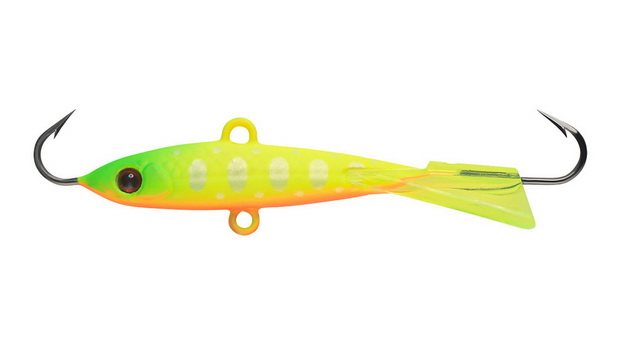
The balancer, called Strike Pro Super Ice by the manufacturer, is a highly catchable bait for winter fishing, comes in several variations and usually has a length of 4-7 cm and a very sensitive weight. Made of metal, the narrow, oblong body has a pointed nose. The large tail, made of plastic, often red, is coated with luminous varnish. Thanks to the features of the device, the bait shows a wide stroke relative to the axis of the hole and helps to check large areas around the hole for the presence of fish. A pronounced game is manifested in both flowing and still water. If the installation of the gear is carried out without errors, the balancer does not twist.
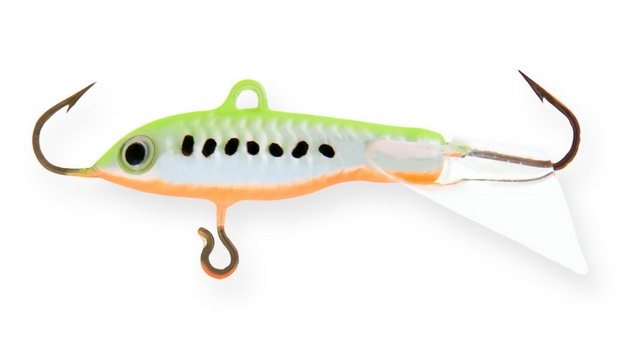
The Ice Baby 25 balance beam from Strike Pro is miniature with an elongated body. Equipped with three hooks and a plastic tail. Beautiful and varied colors will allow everyone to make their choice. The balancer has an excellent action on short throws; when moving upwards with ledges, the action of the bait becomes smooth and slow, which is effective when catching perch in the middle of nowhere. Another wiring option is to shake the balancer at the same level, but so that it does not turn its nose back with each twitch. This game is useful when catching passive perch. For variety, it is useful to play with a balancer and as a jig. At depths of up to 3-4 meters, these balancers are an excellent option for catching perch.
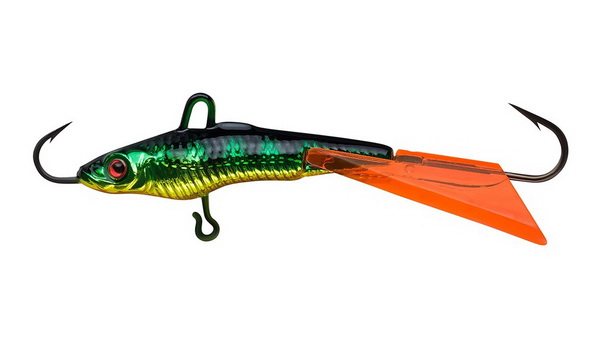
The Strike Pro Challenger Ice balancer is one of the company's most successful models used for ice fishing. Externally, it is a small, oblong-shaped fish with a thickening in the abdominal area. The red plastic used to make the large tail begins to glow at depth, thereby further attracting the predator. The existing paint coating has increased resistance to fish bites, and is made in a wide range of colors, from acid-chemical to ordinary natural colors.
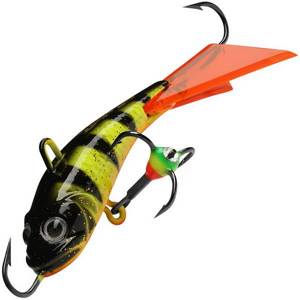
Fishermen who are keen on winter predator fishing know this model very well. Not big and at the same time quite weighty to immediately break through the ice slush that forms in the hole and sink to the very bottom. Strike Pro Dolphin Ice D perfectly helps you catch fish both in still waters and in the current. Indeed, thanks to its large weight, the balancer demonstrates excellent performance even in a strong flow. Its teardrop-shaped body has a specific feature - a flat head bent down. As a result, the natural position of the fish is maintained during play. The DolphinIce D series includes two bait models:
— Heavy 50mm Strike Pro Dolphin Ice D bait weighing almost 37 grams. — A small balancer measuring 40 millimeters and weighing about 19 grams. Balancers by type of fish With Strike Pro balancers you will be able to catch completely different fish. But the manufacturer recommends using a separate model for each type.
To catch perch, it is recommended to use the following balancers:
Strike Pro Dolphin Ice D (large perch) Strike Pro Challenger Ice Strike Pro Ice Baby Strike Pro Micro Ice For pike
Pike can be caught well on:
Strike Pro Micro Ice Shifty Shad Ice Super Ice For zander sudak
Works great for pike perch:
Strike Pro Super Ice D Strike Pro Ice Strike Pro Micro Ice D
The price of Strike Pro balancers is quite adequate for the quality. The price of Strike Pro balancers ranges from 300-500 rubles. It all depends on which model you are interested in.
Read other articles, reviews and testimonials:
- Review of the Lucky John Travel winter fishing rod. Reviews from fishermen about the winter fishing rod Lucky John Travel
- The best balancers. Rating of catchable winter balancers
- The best balancers for pike. Winter pike fishing technique using balance beams
- Lucky John Pliant balancer review. Reviews from fishermen about balance beams Lucky John Pliant
- What weight should I choose for installation on the girders? Sliding or fixed weight on the rack?
Balancer blanks with side wings
Next, we will directly make the petals with our own hands - the bases of the balancers with side wings.
To make it easier to track the text, it is better to transfer all photos to your computer in a separate folder. And let's return once again to the drawing of baits.
Small red dashes in the drawing preliminarily indicate points for soldering loops intended for hanging ready-made balancers with wings to the fishing line of the tackle.
And I would advise you, without cutting out the balancer blanks along the contour (see photo “1”), first punch through longitudinal slots into them, into which the wing blanks are inserted before filling the balancer petals with solder.
Then, turning over the strips of metal, you will see the picture shown in photo “3”.
Why - without cutting? Yes, because this, to some extent, protects the metal of the balancer blanks from deformation when longitudinal slots for the wings are pierced in it.
The slots in my strips of metal were punched using a 15mm wide chisel. Therefore, their length is the same on all workpieces. Your slots may be of a different length.
If you haven’t found a suitable chisel, then simply sharpen a screwdriver with a straight slot at a blade angle of 50-60 degrees and use it to punch holes in the metal workpiece in several steps to the required length.
Next, we turn over the strips of metal blanks with slots punched in them for the approach of the wings of the balancers (photo 3). It is clear that our wing blanks will not fit into such narrow longitudinal holes even without taking into account the fact that it is on this side that the petals will subsequently undergo straightening.
Therefore, we will remove the metal protruding around the seams with a file. You may need to widen the hole several times using the tip of a thin-bladed knife. The blade should be inserted from the front side of the balancer blank.
And to conclude the work, we cut out the petals of the balancer blanks with side wings from strips of metal (photo “5”).
Then we tie a wing blank to each petal blank and adjust the dimensions of the wing to the slot punched in the balancer petal.
Lures with a rotating petal, differences and features
08/14/2014 admin
Jigs with wobblers have recently practically replaced the good old “hardware” from our spinning boxes. But there are cases when you can’t do without a piece of iron, namely, without “spinners” and other lures that have some kind of rotating element in their design. It is these seemingly simple devices that we will talk about, especially their nuances. What types of spinning lures with rotating petals are there and what are their differences and features?
Let's start with the already classic spinners, commonly called “spinners” and “spinners”.
The standard was the products of the MEPPS company, therefore the main terms in designating the types of spinners and the shapes of their petals were taken mostly from its catalogues, for example, dividing the petals by size (from No. 00 to No. 5) and by petal shape (Long rotate at an angle of about 30 °; Comet - 45° and Aglia - 60°). Even when choosing “turntables” from other manufacturers, we still rely on the “Mepps scale” for our own convenience.
However, not all of them have petals like MEPPS; there are quite a few exceptions - for example, American spinners with Colorado-shaped petals. A considerable number of spinners have completely original shapes, and they have their own sizes. These are, first of all, the old Swedish classics from MYRAN or, say, the front-loaded ones from the same MEPPS and BLUE FOX. There are also “turntables” of the “inline” class, distinguished by their special design - they do not have arms (clamps). As an example, we can cite XD spinners from the same MEPPS, as well as a whole line of “spinners” from PANTHER MARTIN.
Rotating spoons are made for fishing in a variety of conditions. For fishing in strong currents, heavier cores are installed, for example, MEPPS Hard Long. Front-loaded “spinners” do not have a core at all, but instead have a sinker-head, which allows them to fish at the bottom using stepped fishing.
The petal of the MEPPS Lusox spinner, for example, is easy to start and works at an angle of 20-25° not only on the retrieve, but also when falling during a pause and when jerking the bait upward - this is the main idea of creating “spinners” of this design. In addition, if you remove the sinker head, you will get an excellent bait for fishing in the surface layer of water, above the grass carpet.
Spinning lures can twist the line. You can deal with this in different ways. One of the options is a front load, the other is a core with a shifted center of gravity, most often in the shape of a fish. SAVAGE GEAR spinners have a core consisting of several balls, one of which is larger than the others, made of tungsten and drilled with an offset. The “turntables” of the Krasnoyarsk company WATER BEETLE have a core that is symmetrical relative to the axis, but the center of gravity is shifted due to the internal cavity. The American “spinner” EPPINGER Osprey Notangle has an anti-twisting device that consists of simply bending the axial wire at an angle of 45°.
If the bait does not have protection against twisting of the fishing line, but catches fish well, then we can always install a swivel. Just be sure to place it closer to the bait, and not on the other side of the leash, otherwise it will be of no use! And don’t put a swivel of unknown origin; you shouldn’t risk the bait, and even the eyes), and the trophy too.
Now a little about the hooks on rotating spoons. Equipping “spinner” tees with additional means, often called decorations, also brings its benefits. In some reservoirs, grayling and trout respond positively to feather flies. Pike rather reacts to an increase in the total volume of the bait, and this can be not only the fly, but also the silicone tail of the twister, or even the “eye” on the tee, rearranged from the winter balancer. However, there are also “spinners” that are initially equipped with smaller spinners - with eyes from the balancer, and larger ones - with branded eyes.
The flies on the tee are mounted in different sizes. Large ones, made from fur from the tail of a deer, elk or cattle, fluff up under water, giving the bait more volume and to some extent covering the hook from the grass and even sometimes saving it from snags. So why do some lures catch better and others worse? Often, two seemingly identical spinners from different manufacturers show completely different results. Let's do a little examination. It is necessary to compare the materials of the petals, their thickness, shape and bend. Then compare the thickness of the wire and the design, the shape of the arms on which the petals rotate.
The petal is usually made of brass (you can check it with a magnet, it is moderately thin, stamped evenly and neatly, the stainless steel wire of the axis is elastic and quite rigid. The arms are even, without nicks or distortions. The arms come in different designs, the most successful ones are made from flattened washers, they less seaweed wraps around itself during wiring due to its more streamlined shape. A petal made of excessively thick metal will be more difficult to engage in work and more likely to get knocked down, an overly thin one will wind up easily, but will be susceptible to various types of injuries. A certain “golden mean” is necessary, and for different The number of spinners is different.
Again, you can take the petals from MEPPS as a standard for metal thickness. MEPPS brackets (clamps) can also serve as samples. Some models of “spinners” from different companies are equipped with very useful devices that help you quickly replace the hook. These devices differ from each other, but in general they perform the given function. A spoon with such a system can be re-equipped quite quickly while fishing - for example, replacing a regular tee with a “decorated” one or a single tee.
In addition to the classic “spinners”, there are other spinning baits that have a rotating petal in their design: “spinners” - Tandems with two petals on one axis; tailspinners and similar lures, the name of which usually contains the word “spinner”, spinnerbaits...
Tandems differ from simple classic spinners only by an additional petal mounted on the same axis. They are bulkier, heavier, create more noise when retrieving and are very effective when catching active fish.
Tailspinners, as a rule, are a massive and weighty body in the shape of a fish made of metal, less often of plastic. This fish is usually equipped with a treble and a petal on a swivel, which is located at the back of the bait.
The Japanese lure DUEL Salt Spinnef is similar to a tail spinner. It has a curious feature - the petal is attached to the bow by means of a winding ring. But the Japanese don’t do anything for nothing, and why complicate the assembly process and add an element to the equipment of the bait? It turns out that fastening the petal in this way makes its operation more stable, and the vibrations created are stronger.
A spinnerbait is a strange, at first glance, bait in the form of a wire “yoke” with a petal at one end! a set of petals, on the other - a sinker-head with a hook with a silicone “skirt”. Not everyone liked her. To understand and accept, it is necessary to master not only the technique of casting it (it is quite saily), but also to understand the technique of its presentation and places of application.
Since the spinnerbait does not fly very far and not as accurately as we would like, it is better to use it in calm weather. The best areas for fishing with spinnerbaits will be thickets of grass with stems standing vertically in the water. These spinning baits usually successfully fight off horsetail and rare reeds. When passing through “windows” of clear water among the grass, let the spinnerbait fall freely to the bottom, while its petal (or petals) will rotate. When the bait reaches the bottom, we lift the bait up with the rod or reel in the reel, making another “step”. That is, the spinnerbait can be driven not only evenly, but also with stepped wiring.
You can also serve this bait with short stops, during which its “skirt” will momentarily bloom like a flower, and at the beginning of the movement fold again. If you can’t catch an overseas miracle, you can replace its “skirt” with a twister or vibrotail, sometimes this helps a lot. More recently, the WATER BEETLE company introduced a spinning bait called Locust (“Locust”) with a rotating petal, which strikes along the ground when retrieved near the bottom. Pike, perch, and large salmon are caught with it.
There is also a group of lures in which the element rotating in the water is some kind of screw, and not a petal. These are all kinds of buzzbaits, homemade products under the general name “turbines” or “propellers,” as well as Devons, in which the body itself rotates due to the work of the blades. Devons are ahead of the rest when it comes to line twisting. I prefer to equip even modern RB company products equipped with bearings with swivels, double, or better yet, triple.
And finally, a little about spinning tackle. Over the past twenty years, many of our fishermen have become seriously interested in “ringing” rods made of high-modulus graphite. However, for fishing with “iron”, “deaf” spinning rods, which are much more modest in terms of material and, accordingly, price, will be quite sufficient. But it is very rare to meet an angler who has a special spinning rod for fishing with classic lures.
For example, for fishing with the smallest rotating baits, I have been using the MAXI-MUS Egoist 76 with a test of up to 10 g for many years in a row. This wonderful universal spinning rod perfectly casts my most microscopic homemade “spinners” and “turbines” when fishing on micro rivers, and The strength of its elegant form is sufficient to withstand very large fish, which sometimes are not averse to attacking such a small bait.
For fishing with small spinnerbaits, tailspinners and spinners up to No. 3, I take the JS Nixx Inshore 76 with a test weight of up to 21 g. It fully lives up to its name (“Onshore”). Like a catapult, he literally shoots any bait “beyond the horizon” without much effort; they say about such bait: “throws it himself.” Although the main purpose of this spinning rod is jig baits, and secondarily wobblers, it copes with “spinners” no worse, and the amazing sensory properties of its blank allow you to feel literally the lightest touch of the bait to something under water - figuratively speaking, “an electric shock” "
As a universal spinning rod for hiking on small rivers or for fishing from a boat, the Nixx Inshore is very good. For the largest spinners and other spinning lures in my boxes, I prefer the MAXIMUS Raptor-X 86 rod in 1 oz. The rod is built extra fast with a powerful butt, moderately “evil”, forward, with an excellent ringing blank and FUJI KR Concept rings in titanium frames. They are a pleasure to work with stubborn No. 4 and 5 spinners, Devons and large spinnerbaits.
And I would like to mention one more spinning rod in connection with this topic, although its purpose is limited primarily to microjig fishing due to the special “solid” tip (solid - glued tip). We are talking about TEAM SALMO Tioga 732MF with a test of 1-8 g. Despite the target orientation of this rod, on some fishing trips I also take, in addition to jig baits, a box of “spinners” from No. 1 and smaller, as well as homemade micro-baits. The fact is that Tioga, if necessary, allows you to fish with very small “spinners”, while the casting range thanks to the soft glued tip is simply phenomenal.
Now a little about coils. We don’t need anything special from a reel for fishing with spinners. I will only note that for fishing in strong currents when casting “upstream”, spinning reels with a high gear ratio, usually about 6.2:1, are useful. At the same time, an increase in the gear ratio leads to a decrease in the power characteristics of the coil. A certain dilemma of choice arises: either slower, but stronger, or faster, but “gentler”.
A kind of “golden mean” can be reels with an increased spool diameter, which increases the reeling speed with a standard gear within 5:1. An example of such a reel is the SALMO Grand Confidence 9130FD with a gear ratio of 5.2:1 and a spool diameter of 55 mm in size 3000.
The new reel pleased me with its light weight (245 g) and excellent cord laying. Both spools are small, when filled with 00.12 mm Power Phantom cord in an unwind of 120 m, backing was not required, the “braid” was enough to reach the very “visor”. This cord was well suited not only for precise winding on the spool, but also due to its strength characteristics and round cross-section (it is better not to use flat cords for fishing with “spinners”).
The topic of “turntables” is too broad to fit into a small article. But let’s not try to embrace the immensity, the main thing for us is to remember that lures with rotating petals should not be put aside, they still work great, are extremely interesting for fish, and fishing with them will be very, very interesting. If you make a good choice...
These articles may interest you
- Fishing for bream in Kineshma
- Fishing for burbot in February in the Urals
- Fishing with an inertial reel “Luck”
- Which baits are better
- Catching fish vertically from the bottom with a rooster
- Casting with an inertial reel
- Our gear
Recent Entries
- Fishing with dragnet
- Making Carolina rigs for pike and perch fishing
- How to equip a Volzhanka 46 Fish boat for fishing
- Winter fishing in Finland, what and how
- About setting up the jig when assembling winter tackle
- Fishing on the Tura River in winter in February
- The A-elita vent is visible from afar
- Winter lure “A-Elita” is the best of all
- How to attach a float rig to a fishing rod?
- Installation of float equipment for fly and plug fishing rods
Advanced site search
Group 1 below in site entries
Bending of the balancer petal with side wings
Before making bends, we remove the unprocessed wing blanks from the petals of the balancers and, using straightening, give the petals of the spinners a convex shape from the front surface. See the material in the article How to bend the petal of a winter spinner.
But it’s better to download my book at the bottom of the page and view the technical process with similar material.
We make the greatest bend along the longitudinal axis of the petal by retreating 1/3 from the nose section of the future balancer.
Next, using sandpaper, we clean the inner curved surfaces of the workpiece petals. Although this operation could have been carried out before the production of bends of the balancer petals with side wings.
Soldering the balancer petal with the side wings
Before soldering and filling with solder, we insert the wing plate into the balancer petal, and I would use solder to place the joint on the inside in the desired position of the wing.
That is, so that on the finished balancer the wings look symmetrical relative to the longitudinal section of the horizontal spinner with a vertical plane (at one angle).
Then we take a wooden block, cut a longitudinal hole in it using a knife and fix the wing together with the balancer petal in the cut hole (photo 7). Next, we fill the homemade balancer blank with solder or lead.
Mechanical processing of the body and wings of the balancer
Next, we give the body of the self-made balancer and its wings the necessary shape using mechanical processing with files and needle files.
As a result, self-made balancers with side wings will take on the appearance shown in photograph “8”.
But, to be honest, I use a small electric sander to mechanically sand all my lures. Therefore, it takes me 10-15 times less time to roughly process the balancer.
Winter fishing rods and reels for balance fishing
For two years now I have been fishing with a Team Dubna Vib special 67HH fishing rod. It appeared as a result of the development of the topic of winter fishing with all kinds of vibes and ratlins, but no one has canceled winter fishing with a balancer! The sensitive form perfectly records the careful tossing of the balancer upon contact with the fish, and even more so precise bites.
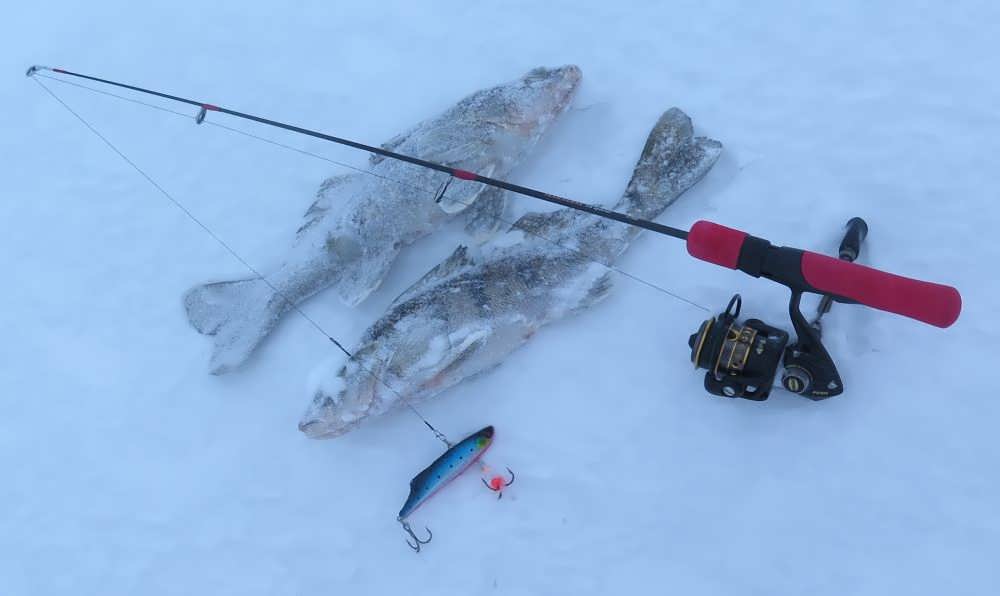
It’s rare that anyone fishes in winter with a spinning reel - but I do
This season I plan to get another Stinger ForceAge Ice 70MH fishing rod - to complete the experience, so to speak. The fact is that at the moment my comrades and I disagree on the rigidity of winter forms. Some argue that fishing hard is bad due to the lack of ability to smoothly play with the balancer. For me, the tougher the better. I understand perfectly well that twitching with a jig spinning rod is inconvenient, but in winter fishing I still don’t see a difference, especially at great depths. But it seems to me that it is much easier to cut through pike perch with a hard blank. I think I will definitely return to this topic, and next season I will give a more complete assessment of these fishing rods.
With winter coils it’s not so simple either. Many of us fish with Stinger Arctic Char reels. They are made of frost-resistant German polycarbonate, have a good disc clutch and are quite compact for winter fishing. But long fishing rods and the ability to catch fish, as they say, at full height, require the use of reels like ForceAge NS 65. This is a new product from the Stinger brand, and I want to test it in operation, comparing it with the American reel 13 Fishing Betty Free Fall Ghost, which I'm catching it now.
In general, when I worked in a fishing store, many different reels passed through my hands. I played with the Lucky John and Team Dubna Ice Game models, they also deserve attention. However, I somehow liked the ForceAge NS 65 better both in terms of workmanship and price.
I also have a small winter spinning reel Penn Battle II 1000, which is simply indestructible, but I don’t use it often. Most often during a thaw or at zero temperature. Now I completely forgot, since all its functions (clutch and reset) are found in the above-mentioned coils.
Soldering hooks into a balancer with side wings
The next step is to solder the hooks into the bodies of the balancers with the side wings.
It is better to solder the fishing hook into the nose end of the balancer so that the sharp end of the tip is located flush with the nose cut of the spinner body or extended relative to it by 1-1.5 mm.
Considering that the tail hook must be equipped with an artificial nozzle, it should be soldered so that the tip of its tip does not reach the tail section of the balancer body with side wings by 3-3.5 mm.
Both hooks are soldered with stings directed to the upper side edge of the balancer, and a loop is soldered between them for hanging the bait from the fishing line. But before soldering the loop, I would strongly recommend that you complete the final finishing of the spinner, otherwise the soldered loop will create unnecessary problems for us during finishing.
Soldering the balancer loop with side wings
Next, on the upper edge of the balancer with side wings, select a place to solder the loop. There is one simplest and fastest way to do this. I haven’t talked about it anywhere yet, but it will probably be the best and fastest and will be useful in our future work.
We need to pull out a single thin elastic band from somewhere, tie a small loop at its end and thread our balancer into it. The elastic knot should be on the top edge of the bait. That is, on the side where the loop will be soldered.
By moving the rubber loop along the body of a homemade balancer, you should find a place where the suspended bait takes a horizontal position (meaning the horizontal axis of the spoon). But a more important condition will be the lift angle of the blades. That is, their planes should descend towards the tail of the spinner body at an angle of 5-7 degrees.
After soldering the loop, we are left with the complete finishing of a completely self-made balancer with a pair of side wings. In photo “9” the baits are shown in their finished “commercial” form.
Pike perch on balance beam
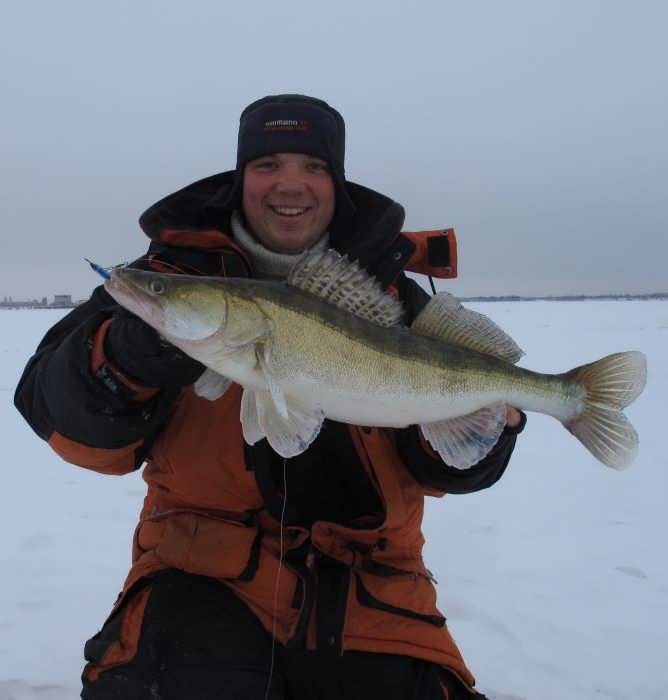
Midwinter - time to catch pike perch on a balance beam
For a long time I didn’t even try to catch pike perch using a balance beam. I made do with other winter baits. A jig with a fry, a spinner or a large “Devil”. But I kept hearing rumors that on the Volgograd Reservoir they catch pike perch quite well using a balance beam. The first information is that fishermen place fry on the lower tee. Here I don’t understand at all - why? In this case, the balancer’s own “game” is completely lost. Windage in the current increases. It’s better to take a regular jig. But the fact remains – they get caught!
Until the moment when I became interested in catching pike perch using ratlins, I really didn’t have any good pike perch balancers. I mean heavy ones that will drag 25 meters of cord or fishing line to the bottom in a small current. But looking at my colleagues, I decided that I definitely needed to fill this gap in pike perch baits. In my head I can see a picture of the bulls quickly moving from place to place, in short leaps - why not a “game” of the balancer?
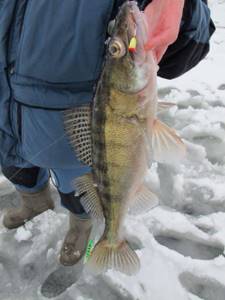
A small suspension above the balancer sometimes catches better
This season I have expanded the line of Usami Dansa balancers with a pike theme - Pike Special, and also with a zander theme - Zander Special. I love, you know, different sizes or depths of baits.
If the Usami Dansa balancer is right for you, you need to allocate a place in the box for the whole family. Of course, the light didn’t shine on Usami. I have Mebaru from Lucky John in my arsenal, and Nils Master. Which one of them will catch the pike perch first is interesting. In the meantime, my favorite for zander is the narrow, heavy Ice Jigger from Spider. Once upon a time, at an exhibition at VDNKh, they gave me a try - it is still alive, but I use it exclusively on strong currents (Don or Akhtuba).
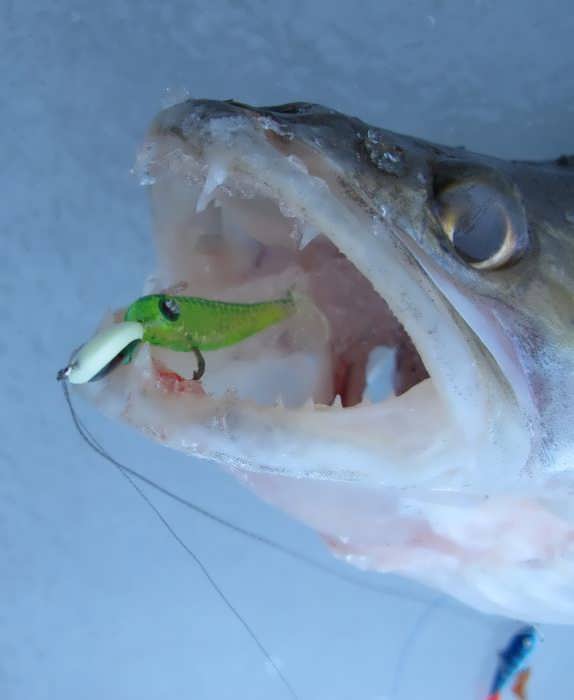
The pendant can be retrofitted with edible silicone
There is one more feature in catching pike perch using balance beams. Around the middle of winter, something strange happens. Pike perch is starting to catch well on small balancers. It would seem that a large balancer should cut off small pike perch, but practice shows that large pike perch are more likely to bite on small bait. I completely agree with this practical point of view, since in the middle of winter I often caught large “Devils” - and did not at all complain about the lack of bite. I have already mentioned the Mebaru balancer from Lucky John, which is compact and heavy for our depths.
Adjusting the balancer with side wings
Setting up a balancer with side wings is first done by balancing the center of gravity of the bait.
To do this, we hang a balancer equipped with an artificial attachment on a fishing line and, by bending the loop to its right or left side plane, we align the spoon in space.
After this operation, the wings on both sides of the homemade balancer should be at the same angle to the horizontal plane.
In addition, if the bait has received a large asymmetry of the sides during soldering and processing, then bending the loop in one direction or another will help to some extent eliminate this defect. Using a similar setting in a balancer with side wings, the center of gravity shifts relative to the suspension point.
Changing the bending of the wing tips also significantly changes the trajectories of the balancer wiring. But I previously performed both of these operations when testing baits in the bathroom.
The speed characteristics of the wiring of balancers with side wings depend to a very large extent on the volume of artificial baits on the tail hooks, and the stability of the trajectories of the wiring of homemade baits also depends on them. You saw options for artificial attachments in photographs and when watching videos.
START OF TOPIC:
Winter balancer for perch
***
Tackle for fishing with balance beam
Tackle for fishing with a balance beam As you know, this bait can be fished both in a sitting and standing position.
If you like to fish while sitting, then use shorter rods. In this regard, everything depends on your desires, but it is best not to use very short rods for this fishing, since it will be difficult to achieve much variety in the game of the balancer. But it is best to catch while standing; it is much more convenient, although more energy-consuming. Therefore, it still wouldn’t hurt to have in your arsenal both a long rod (for fishing while standing) and a short one (for fishing while sitting), so that you can rest from time to time, without ceasing to fish (after all, winter days are short).
A standing rod for fishing, reminiscent of a short spinning rod. It is worth purchasing a lightweight rod, firstly, you will have to lift it hundreds of times during fishing, therefore, your hand will get very tired, and secondly, the sensitivity of such a rod will be very high, and you will be able to recognize a bite, even from an inactive and small fish.
It is also worth saying that many fishermen put a nod, but this is not necessary in all cases. On short rods it will obviously not be superfluous, but on long rods, it needs to be installed if you are using monofilament, which without a nod makes it difficult to determine the bite, since it stretches. And when using braid, even without a nod, you can determine the bite if the rod is not rigid. On a hard rod, you can’t do without a nod.
As with spinning fishing, a fishing rod for fishing with a balance beam must be selected depending on the weight and size of the bait. This is natural, if you fish with small balancers and use a rigid rod, you will not achieve the correct action of the balancer, since the rod will not even bend and the action will be very sharp. The same applies to fishing with a light fishing rod when using large baits.
As for the nod, it all depends on your preferences. Some people use it, others say that it is unnecessary. I have already said that when using monofilament, a nod is necessary; when using braid, you don’t need to use nods. A nod, whatever one may say, reduces the impact on the hand when biting (if it is hard), although with inactive fish, it is sometimes impossible to do without a nod, so whether it is needed or not is a moot point.
